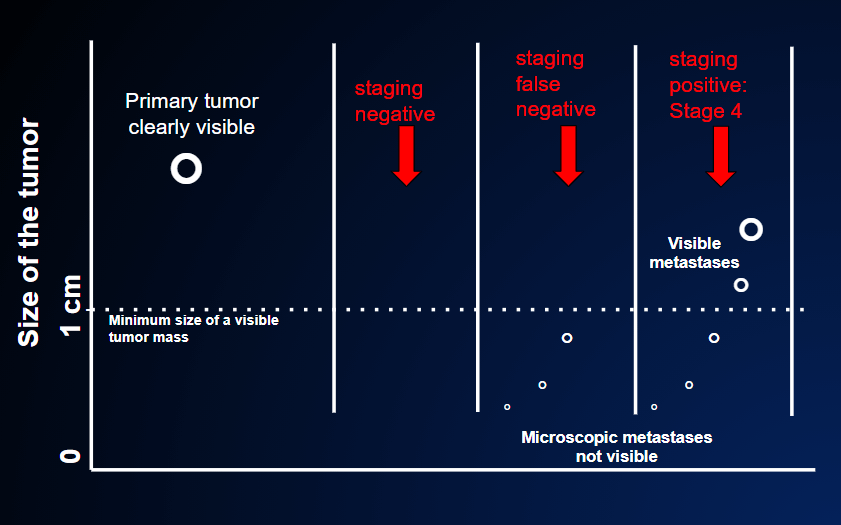Neoadjuvant therapy is therapy administered before the surgical operation. It has three aims.
- The first: to shrink the tumor so that it can be removed surgically. (INITIAL TREATMENT ACCORDING TO THE STAGE)
- The second: to enable preventive therapy to be started as soon as possible against any metastases that may already be present, but which are not yet detectable by staging examinations. FIGURE 2

There are 3 possible outcomes of staging, which is the assessment of whether the tumor has spread to distant organs.
In the first case, the staging result is truly negative because the primary tumor has not spread outside the local site of origin as evidenced by negative CT, PET scan and magnetic resonance tests (=no tumor in other organs). After the primary tumor is removed, the patient is cured.
In the second case, the staging result is falsely negative because although the CT, PET scan and magnetic resonance tests are negative (=no tumor in other organs) the primary tumor has already spread outside the local origin, but these small nodules are too small to be revealed by the imaging tests. These tests usually disclose nodules of at least 0.5-1 cm (the dotted line in the figure). After the primary tumor is removed, the patient is not cured. A relapse will become known when these small nodules have grown above that threshold.
In the third case, the staging result is positive (=presence of cancer in other organs) because metastases are already seen by the staging tests: they are already large enough at the time the primary cancer is discovered.
Indeed, when there is a high risk that there are already metastases, the time spent waiting for surgery and then for the patient to recover after may mean that the disease will have more time to spread. This second aim therefore justifies the administration of neoadjuvant therapies even when the primary tumor can be removed. The purpose of neoadjuvant therapy is the same as that of post-operative preventive therapy (adjuvant therapy): to eliminate micrometastases, if there are any.
- The third: concerns a few situations in which a surgical operation to remove the tumor would be very destructive and could weaken the patient to the extent that post-operative preventive therapy cannot be administered. This is the case, for example, of tumors of the stomach and esophagus. Preventive therapy administered before surgery (ineoadjuvant) is preferable, being better tolerated and more effective, because it is administered earlier.
The duration of neoadjuvant therapy is, in any case, limited, as medical therapies have their greatest effect in the first few months. In general, after about 2-4 months of treatment, local and distant staging examinations are repeated in order to reassess the situation, to see if the tumor is operable and, if possible, to decide when surgery should be performed.
